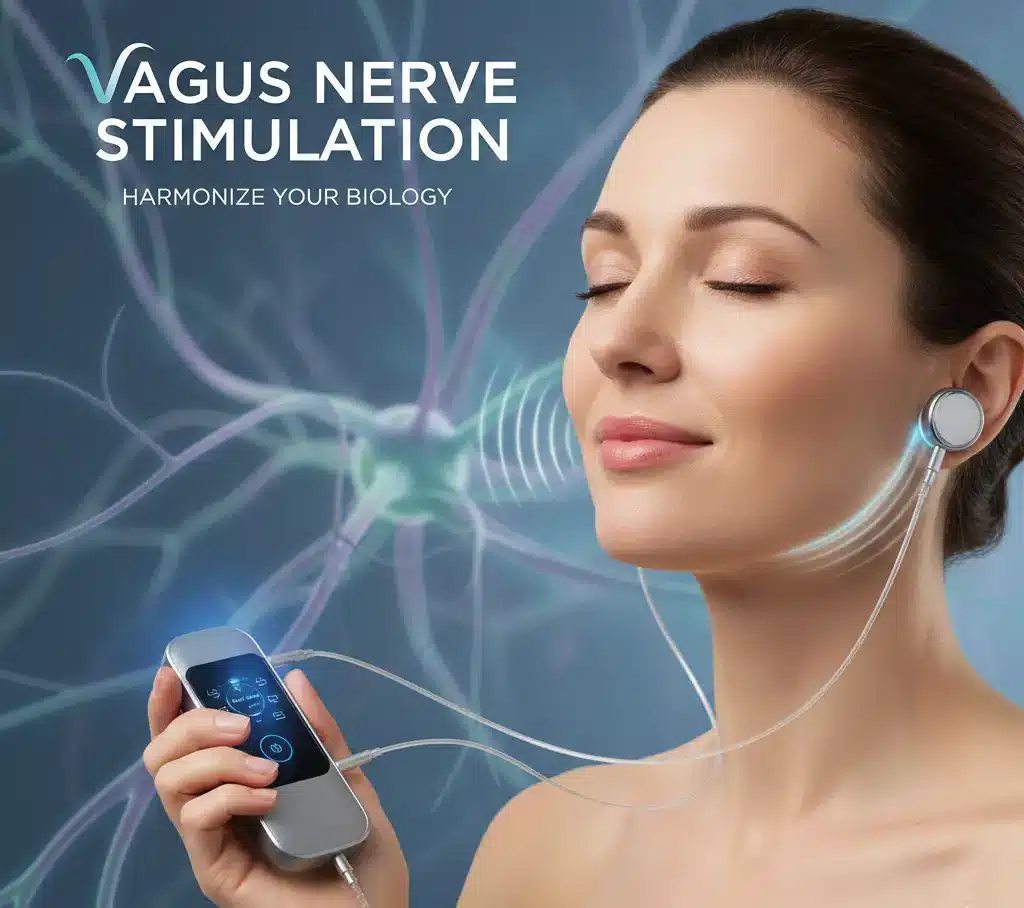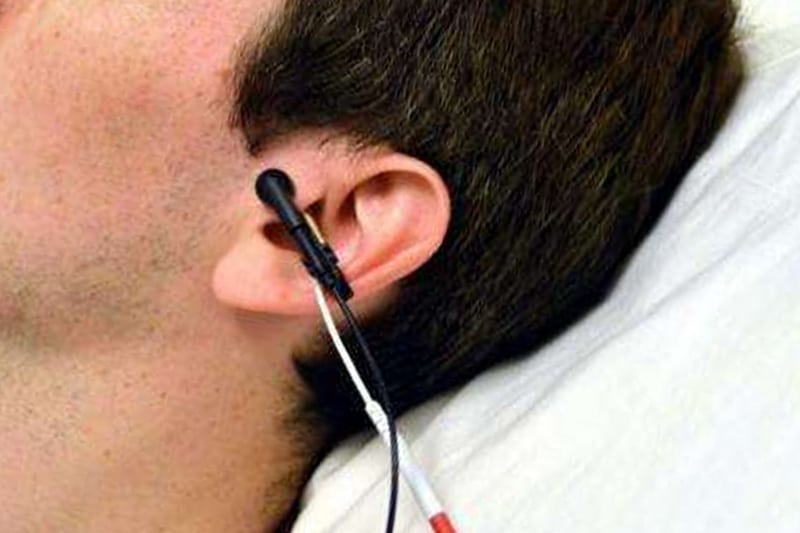Non-invasive Vagus Nerve stimulation (VNS) affects a wide range of inflammatory, digestive, and neurological conditions. The Vagus nerve provides a two-way communication network between the brain and your body.
I’m Louise, and at Balance Acupuncture Brisbane, located at the Clem Jones Centre in Carina, we care for our patients by providing ongoing VNS treatment.

Where is Vagus nerve found?
The vagus nerve originates in the brain as the 10th cranial nerve and connects the brain to major body organs in the neck, chest and abdomen, a small branch goes to the external ear.
How to stimulate Vagus nerve?
Stimulation of the vagus nerve occurs via the external ear, using ear clips and a TENS unit. The vagus nerve oversees a lot of really important bodily functions and has plenty of roles within the body when it comes to healing and wellbeing, including:
How does Balance Acupuncture Brisbane Support Vagus Nerve Health?
Acupuncture and Autonomic Nerve Imbalance
The sympathetic and parasympathetic nervous systems are the autonomic nervous system components. They are considered the Yin and Yang of the autonomic nervous system, maintaining homeostasis by functioning in opposite yet complementary ways.” Kiiko Matsumoto, p105 (2012.)
Kiiko Matsumoto Style Acupuncture (KMS) is a palpation-based meridian style of acupuncture. A detailed history will reveal sympathetic dominance symptoms, which might include:
The most common signs on examination include a rapid pulse, a tight sternocleidomastoid (SCM) muscle, and pressure pain along the upper spine.
Alternatively, parasympathetic dominance may show up after chronic “fight or flight” sympathetic dominance, and presentation may manifest as fatigue, digestive issues, and a sensation of heaviness in the limbs. Examination findings often include a slow pulse and a relaxed, less reactive SCM muscle. Adrenal and immune reflexes are frequently present.
What to Expect in a Vagus Nerve Acupuncture Session?
Treatment plans can combine tVNS with a Vagus nerve acupuncture session for a more comprehensive approach. Acupuncture calms the reflexes or reactive areas identified through palpation, helping to restore balance in the body.
In the style of Kiiko Matsumoto, specific points along the San Jiao (SJ) meridian are often selected, particularly to address sensitivity in the sternocleidomastoid (SCM) muscle. This meridian travels from the tip of the middle finger, along the back of the forearm and upper arm, up the side of the neck, and around the ear, ending at the outer edge of the eyebrow.
Similarly, Lee et al. (2018) observed that stimulation of HT7, an acupuncture point at the wrist, calmed the autonomic nervous system, further supporting its role in modulating vagal pathways.
Each session at Balance Acupuncture Brisbane, located near Carindale, is uniquely tailored. It provides a calm and responsive experience that adapts to the individual’s needs in real-time. Most people report that acupuncture induces a deep sense of relaxation.
What does stimulating Vagus nerve do?
Increased vagal tone improves our stress response, allowing us to be more resilient and improve our brain-body connection. Vagus Nerve Stimulation may be used in conjunction with other treatment options to provide you with the best overall treatment for your health.
Vagus nerve stimulation benefits: Stress and anxiety relief
VNS reduces sympathetic nervous system activity, lowering physiological stress responses.
Studies have shown that non-invasive VNS decreases markers of sympathetic arousal, such as heart rate and skin conductance, indicating a calming effect on the body during stress (Clancy et al., 2014).
VNS improves heart rate variability (HRV), a biomarker of stress resilience.
Higher HRV reflects better autonomic regulation and a more adaptive stress response. VNS has been consistently associated with increased HRV, suggesting improved parasympathetic (vagal) tone and reduced stress (Badran et al., 2018).
VNS modulates brain regions involved in emotional regulation and stress processing.
Functional MRI studies demonstrate that VNS influences areas such as the amygdala and prefrontal cortex, which are key in managing emotional responses to stress (Frangos et al., 2015).
Resetting Vagus nerve improves sleep
Enhances relaxation and reduces arousal: VNS increases parasympathetic activity, helping the body relax and reducing the physiological stress responses that can interfere with falling and staying asleep.
Supports deep, restorative sleep: Research shows that VNS can help regulate circadian rhythms and promote slow-wave (deep) sleep, essential for physical and mental recovery (Burger et al., 2020).
Improves long-term sleep quality: VNS has been shown to improve heart rate variability (HRV), indicating better autonomic balance during sleep. According to Zhang et al. (2020), an 8-week course of VNS treatment significantly reduced the severity of insomnia, with benefits continuing beyond the treatment period.
Final Thoughts: Calm Your Body, Support Your Nervous System
At Balance Acupuncture, a step from Carindale, we combine gentle acupuncture with tVNS to support your nervous system, improve vagal tone, reduce stress, boost Vagus nerve healing and help restore harmony in your body.
Whether you’re seeking relief from stress or digestive upsets, looking to sleep better, or just enhancing your overall well-being, we tailor each session to your unique needs.
Book a session at Balance Acupuncture Brisbane with our experienced acupuncturist in Carina Heights today.
References
Below are links to current research on VNS:
- https://doi.org/10.3389/fnins.2019.00854
- https://www.pnas.org/content/suppl/2016/06/30/1605635113.DCSupplemental
- https://doi.org/10.3389/fnins.2019.00280
- https://www.ncbi.nlm.nih.gov/pmc/articles/PMC3893663/?fbclid=IwAR2c_T3jMQC84G3vPD4fRcGqAmLbuICUhBLjD0oqaCK7zH4wy0qbzoWjERQ
Badran, B. W., et al. (2018). Transcutaneous auricular Vagus nerve stimulation: State of the art. Neural Plasticity, 2018, Article ID 8239232. https://doi.org/10.1155/2018/8239232
Bonaz, B., et al. (2016). Vagus nerve stimulation: A new promising therapeutic tool in inflammatory bowel disease. Journal of Internal Medicine, 280(1), 51–63. https://doi.org/10.1111/joim.12402
Bonaz, B., Sinniger, V. and Pellissier, S. (2016), Anti-inflammatory properties of the Vagus nerve: potential therapeutic implications of Vagus nerve stimulation. J Physiol, 594: 5781-5790. https://doi.org/10.1113/JP271539
Burger, A. M., D’Agostini, M., Verkuil, B., & Van Diest, I. (2020). Moving beyond belief: A narrative review of potential biomarkers for transcutaneous Vagus nerve stimulation. Psychophysiology, 57(2), e13352. https://doi.org/10.1111/psyp.13352
Clancy, J. A., et al. (2014). Non-invasive Vagus nerve stimulation in healthy humans reduces sympathetic nerve activity. Brain Stimulation, 7(6), 871–877. https://doi.org/10.1016/j.brs.2014.07.031
Fedorowski, A. (2019). Postural orthostatic tachycardia syndrome: Clinical presentation, aetiology and management. Journal of Internal Medicine, 285(4), 352–366. https://doi.org/10.1111/joim.12852
Frangos, E., Ellrich, J., & Komisaruk, B. R. (2015). Non-invasive Access to the Vagus Nerve Central Projections via Electrical Stimulation of the External Ear: fMRI Evidence in Humans. Brain Stimulation, 8(3), 624–636. https://doi.org/10.1016/j.brs.2014.11.018
Hong, G. S., et al. (2019). Effect of transcutaneous auricular Vagus nerve stimulation on gastric motility and emptying in healthy subjects. Neurogastroenterology & Motility, 31(5), e13599. https://doi.org/10.1111/nmo.13599
Jonsjö, M. A., et al. (2020). Heart rate variability as a marker of emotional and physiological distress in IBS patients: A systematic review. Neurogastroenterology & Motility, 32(6), e13865. https://doi.org/10.1111/nmo.13865
Koopman, F. A., et al. (2016). Vagus nerve stimulation inhibits cytokine production and attenuates disease severity in rheumatoid arthritis. Proceedings of the National Academy of Sciences, 113(29), 8284–8289. https://doi.org/10.1073/pnas.1605635113
Kovacic, K., et al. (2017). Neurostimulation for abdominal pain-related functional gastrointestinal disorders in adolescents: A pilot study. Neurogastroenterology & Motility, 29(1), e12944. https://doi.org/10.1111/nmo.12944
Larkin, K., Tiani, A., & Brown, L. (2021, February 23). Cardiac Vagal Tone and Stress. Oxford Research Encyclopedia of Neuroscience. Retrieved 15 May. 2025, from https://oxfordre.com/neuroscience/view/10.1093/acrefore/9780190264086.001.0001/acrefore-9780190264086-e-268.
Lee, B., Kim, S. H., Kim, S. N., & Park, H. J. (2018). Effects of acupuncture on heart rate variability in subjects under mental stress. Journal of Acupuncture and Meridian Studies, 11(2), 67–72. https://doi.org/10.1016/j.jams.2018.01.003
Matsumoto, K. & Euler D., 2012, Kiiko Matsumoto’s clinical Studies: In The Spirit of Master Nagano, vol1, Kiiko Matsumoto International.
Tracey, K. J. (2002). The inflammatory reflex. Nature, 420, 853–859. https://doi.org/10.1038/nature01321
Zhang S, Zhao Y, Qin Z, et al. Transcutaneous Auricular Vagus Nerve Stimulation for Chronic Insomnia Disorder: A Randomized Clinical Trial. JAMA Netw Open. 2024;7(12):e2451217. doi:10.1001/jamanetworkopen.2024.51217


